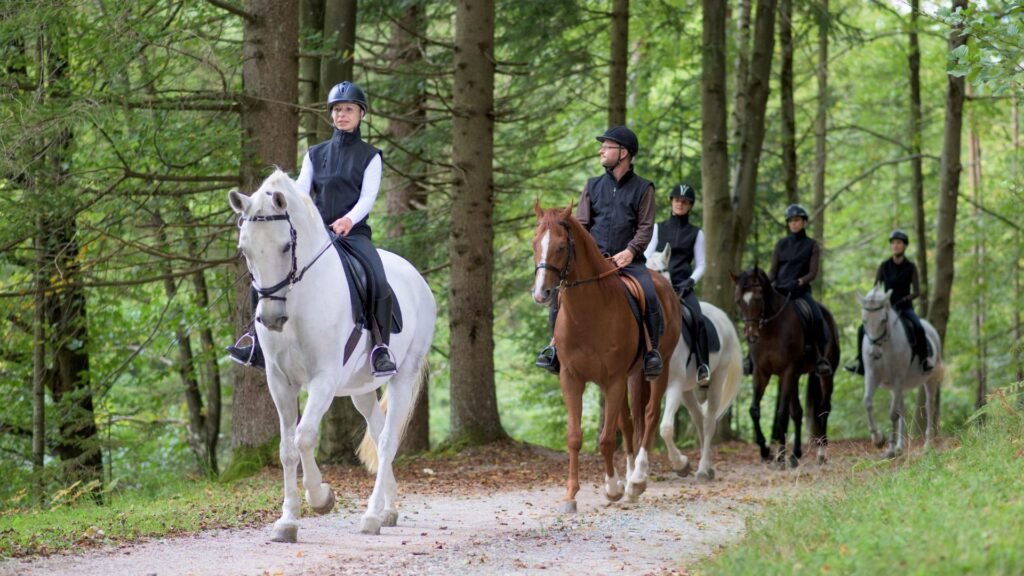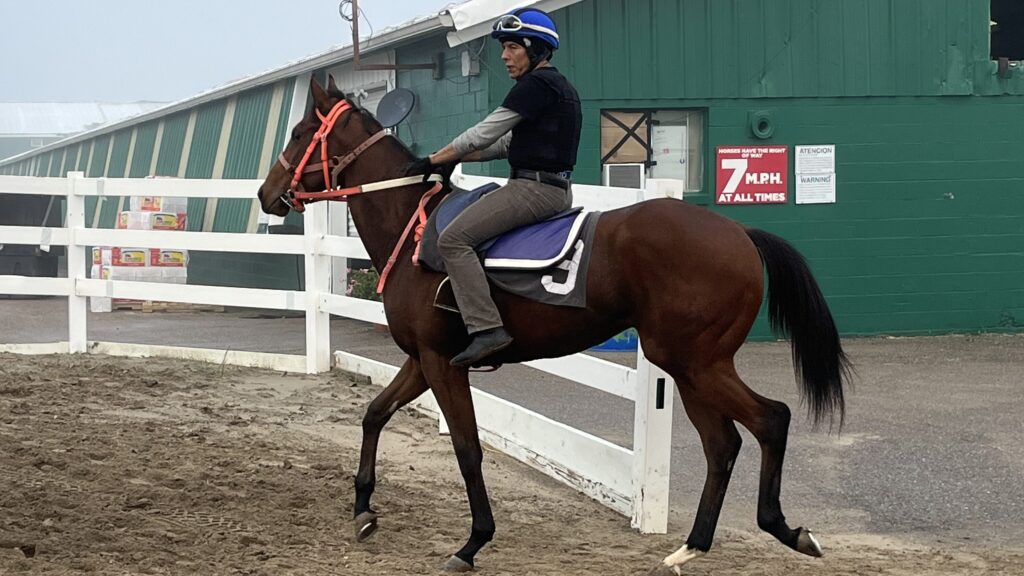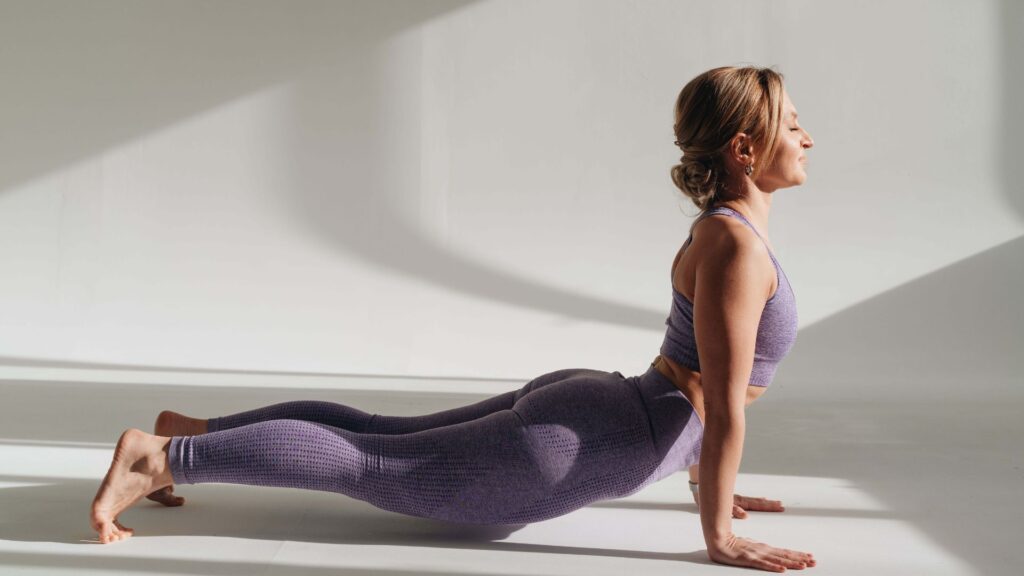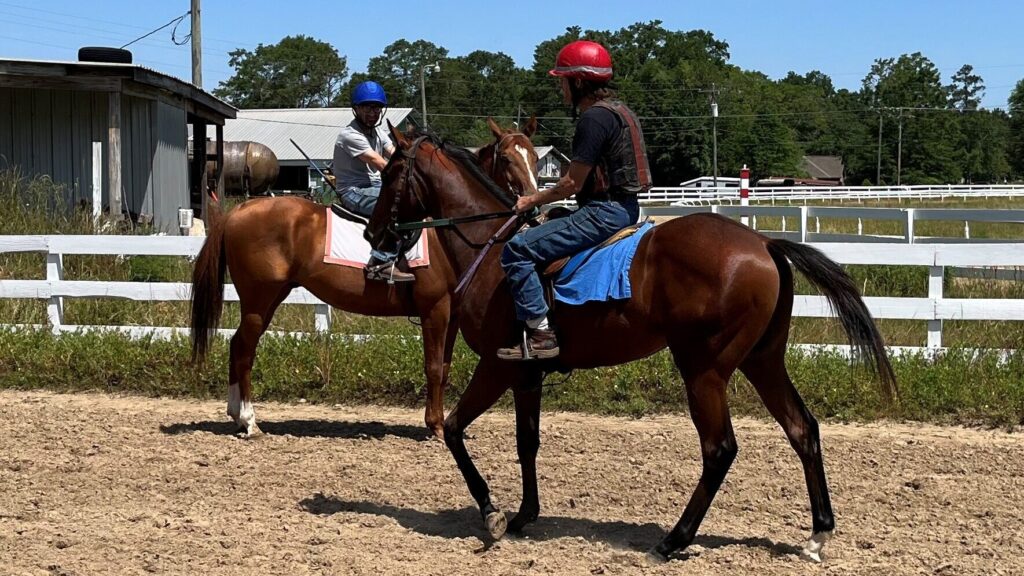Last updated: March 23, 2023
After completing a horseback ride, my niece mentioned experiencing muscle soreness in areas she was previously unaware of. Despite this, she thoroughly enjoyed the experience and now wishes to ride horses regularly. She has asked me for suggestions on exercises to help improve her riding form and ways to learn the proper seat position while riding.
To improve your position as a beginner horse rider, focus on strengthening muscle groups that support good posture. Enhancing your stability, fitness, and flexibility will give you better control over your horse and improve your riding skills. Good posture and control are essential for your safety and for communicating with your horse.
This blog post will cover essential position tips and exercises that every beginner horse rider should know. From finding the perfect balance in the saddle to strengthening your core and leg muscles, these tips and exercises will set you up for success. So if you’re ready to take the reins and start your journey into the world of horse riding, read on.
Finding the Right Balance in the Saddle
Riding a horse requires a combination of physical strength and mental focus. Finding the right balance in the saddle is essential for both the rider’s comfort and the horse’s well-being.
A balanced seat allows the rider to communicate effectively with the horse and respond to the horse’s movements. It also helps the rider maintain control and prevent falls.
Maintaining balance while riding can be challenging, especially for beginners. However, with practice and the right techniques, riders can learn to maintain a secure and comfortable position in the saddle.

Several tips and practices can help riders maintain a balanced seat in the saddle. Here are a few to consider:
- Align your pelvis: Proper pelvis alignment is key to maintaining balance in the saddle. When riding, try to keep your pelvis level and centered over the horse’s back. This will help you stay balanced and responsive to the horse’s movements.
- Use your core muscles: Engaging your core muscles can help you maintain balance and stability in the saddle. To do this, try contracting your abdominal muscles and lifting your chest slightly. This will help you maintain an upright and balanced position.
- Practice good posture: Good posture is essential for maintaining balance in the saddle. Keep your shoulders back and down, and try to keep your head and eyes up. This will help you stay centered and balanced over the horse’s back.
- Focus on your breathing: Deep, steady breathing can help you relax and stay focused while riding. Try to take slow, deep breaths in through your nose and out through your mouth to help you maintain balance and control.
It’s also important to always wear a helmet and appropriate protective gear when horse riding and follow all safety guidelines and procedures. With practice and patience, you’ll soon be able to enjoy the thrill of horse riding with confidence and control.
Beginner Horse Riding Position Tips
Proper position is essential for effective communication with the horse and for maintaining balance while riding. It involves sitting upright with a relaxed but alert posture, with your heels down and toes pointing forward. It’s also important to keep your hands and arms relaxed, allowing the horse to respond to your subtle cues.
A beginner horse rider should sit upright and tall on their horse, with a foot set in each stirrup. The rider should relax their back, but not slouch. The focus should be on balance and even weight distribution to accommodate the horse’s load. Additionally, a rider should gently hold the horse’s reins with a bit of slack so it can move its head freely.
A horse rider should be able to sit comfortably and with stability when a horse walks, trots, canters, or gallops. So, a large part of horse riding is having a rapport with your horse and synchronizing your own body movements according to their different gaits and speeds.
The Importance Of Position In Communicating With Your Horse
Beginner riders should know that a large part of horse riding is your relationship with the horse. You should respect and communicate with your horse and gain its trust. Horses are sentient beings, and you communicate with them verbally and nonverbally – including sitting in the saddle and holding the reins.
To this end, beginner horse riders should remember the following:
- You and your horse are a team and must accommodate each other while riding.
- A rider must coordinate their posture with their horse’s symmetry and balance.
- While on a horse, a rider must remain still and stable yet also flexible and fluid.

Tips On How To Maintain Your Position While Horse Riding
There are four main areas of your body that you can focus on to maintain your position while riding horses. They are your pelvis, legs, shoulders and neck, and arms and hands.
Your Pelvis Position When Horse Riding
When your pelvis is positioned correctly during horse riding, you will feel more secure and balanced in the saddle. The ideal pelvic position is Neutral, where your spine is neutral, and your seat bones are pointed straight down.
The neutral position helps with the following:
- Shock absorption when riding, and
- Flexibility through your hips.
This YouTube video indicates how to find the neutral pelvic position and exercises to strengthen your pelvic area.
The other two less desirable pelvic positions are:
- The Interior Rotation position where your back is arched, and you ride on your pubic bone with your seat bones “behind” you, and
- The Posterior Rotation position is where your back is slouched, and your seat bones are pointed forward.
If you struggle to sit in the ideal position, it might be that your hip flexors are tight or your core muscles need strengthening.
- You can do gentle hip flexors, and butterfly stretches to loosen your hip flexors.
- To strengthen your core muscles, you can do planks.
The Position Of Your Legs While Horse Riding
As a horse rider, you will use your legs to help you stay on your horse. However, your legs also have the job of absorbing shock when the horse is moving. This means your legs must be stable yet relaxed when riding.
The main leg muscles and tendons you use during horse riding are:
- Quadriceps
- Medial Gluteus
- Hamstrings
- Calves
- Achilles’ tendons
The correct leg position when riding is described as the following:
- Your knee should have a slight bend, allowing your thigh to extend in front of you,
- Your knees should be “open,” meaning not clenching the horse,
- Your toes should point straight and slightly lifted,
- Your heels should point down slightly but not enough to lock your ankles and knees.
Gripping your horse with your thighs, knees, or calves will push you up and out of the saddle. As a result, you will have less contact with the horse and feel less stable.
Some leg-strengthening exercises you can do to improve your horse-riding position include:
- Wall sits for your quadriceps
- Squats for your hamstrings and glutes
- Side leg lifts will strengthen your medial glutes
Your Shoulders And Neck Position While Horse Riding
Holding your neck and shoulders in the correct position will help you to maintain your ideal posture and stability. The neck and shoulder muscles involved in horse riding are:
- The trapezius muscles
- Lateral muscles
- Pectoral muscles
The correct neck and shoulder position when riding is when the rider:
- Opens up their collarbones,
- Drops their shoulders, and
- Holds their neck straight.
To practice this horse-riding position, you can pretend to hold a heavy platter steady with both hands. Remember, if you tighten your shoulder muscles and pull them backward, it will heighten your center of gravity, and you will lose stability.
Great exercises you can do to strengthen your neck and shoulders are:
- Wall stretches
- Door stretches
- Superman stretches
- Bird Dog stretches
The Position Of Your Arms and Hands While Horse Riding
The position of your arms and hands is important in keeping your whole body balanced while horse riding. The correct way to hold your arms and hands is as follows:
- Your elbows should be slightly bent and next to your sides,
- Your shoulder blades should be down and pushed back a bit,
- Your thumbs up, and
- Your wrists are in (close together).
If your elbows are straight or sticking out, it will change your center of gravity, and you will lose stability.
The muscles that support proper arm and hand position are the laterals, obliques, and triceps.
To practice “quiet hands,” or hand stability, you can place a whip between your thumbs and index fingers as you hold the reins. Additionally, you can work on strengthening your abdominal and back muscles to help your balance.
Tips For Staying In Control While Riding
Maintaining your position while horse riding means working on various aspects of your fitness and biomechanics. If you have more control over your body, there is a better chance of communicating effectively with your horse. Remember, horses are big and powerful creatures, so you can’t be a floppy blob in the saddle and hope things go well.
Essential aspects of improving your fitness and biomechanics for horse riding include the following:
- Alignment,
- Correct riding posture,
- Flexibility,
- Physical strength,
- Stability (core muscles), and
- Stamina.

Exercises To Improve Your Positioning When Horse Riding
Beginner horse riders who want to improve their position should strengthen specific muscle groups that help with posture. As a horse rider, it is essential to have enhanced stability, fitness, and flexibility. These will allow you better control over your horse as you move as a synchronized team.
Doing a few exercises and stretches before mounting your horse can help improve your position immensely. For example, yoga and Pilates are both great ways to stretch and strengthen the critical muscle groups needed for stability in riding a horse.
Strengthening Your Core and Leg Muscles
Having strong core and leg muscles can greatly improve your riding position and control. The core muscles, including the abdominal and back muscles, help to stabilize the body and provide a strong foundation for the upper body.
Strong leg muscles, particularly the glutes, quadriceps, and calves, are important for maintaining balance and control in the saddle. To improve your core and leg muscles for riding, consider incorporating exercises such as planks, squats, and lunges into your fitness routine.
These exercises can help you build strength and improve your riding position and control. Other exercises you can do at home to improve your stability and overall equestrian fitness are:
- Bent over dumbbell, barbell, or resistance band rows
- Calf raises
- Downward dog to knee drive
- Single leg bridge
- Single leg deadlift
- Supine toe taps
- Walking lunges
- Walkouts to push-up
The benefits of being flexible as a horse rider
Being flexible can provide several benefits for horse riders. Some of the benefits of being flexible as a horse rider include the following:
- Improved balance and control
- Enhanced communication with the horse
- Reduced risk of injury
- Increased comfort
To improve flexibility for riding, riders can try incorporating stretching and yoga exercises into their fitness routine. Stretching can help improve flexibility in the hips, legs, and lower back, which are all important for riding.

Conclusion
Horse riding can be a physically demanding activity, especially for beginners who might be using muscles they didn’t even know they had. That’s why stretching properly and exercising before getting on a horse is important.
Riders should strengthen the muscle groups that help them sit correctly. The pelvis, back, neck, shoulders, arms, hands, legs, and feet all play a role in stabilizing a horse rider.
Strengthening the muscles and practicing correct positioning will help you feel more prepared and comfortable while riding. Beginner riders can also balance on their horse and communicate more effectively with it.
By incorporating stretching and exercise into your horse riding routine, you’ll be able to fully enjoy the experience and all the benefits that come with it.
FAQs
Why do people post while riding?
Posting is a common technique used by riders to maintain balance and control while riding at a trot. When riders post, they rise up and down in the saddle in sync with the horse’s gait.
Why is horse riding expensive?
Horse riding can be expensive due to the specialized equipment, training, and care required. However, you can reduce the cost of horse riding by sharing equipment or lessons with others, participating in local events rather than traveling, and finding ways to save on horse care costs.
References
https://www.fei.org/stories/lifestyle/health-fitness/fitness-2021-strength-building-equestrians

About the Author: Miles Henry
Lifelong Horseman | Racehorse Owner | Published Author
Miles Henry brings over 25 years of hands-on experience training and owning Thoroughbred racehorses. Raised with Quarter Horses and Appaloosas, he’s spent a lifetime learning from horses—on the track, in the barn, and in the field. Today, he runs a small but successful racing stable in Louisiana and shares real-world insights on HorseRacingSense.com, helping horse owners, fans, and bettors navigate the sport with confidence.
📚 Books: View Miles’s books on Amazon »
🎧 Podcast Guest: Animal Tales Ep. 32 |
YouTube Interview
📩 Newsletter: Sign up for racing tips and horse care advice »
🔗 Follow Miles:
Twitter |
Facebook |
YouTube





